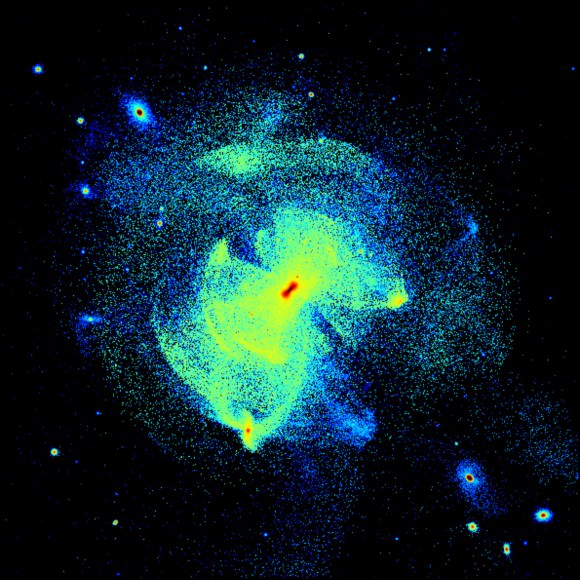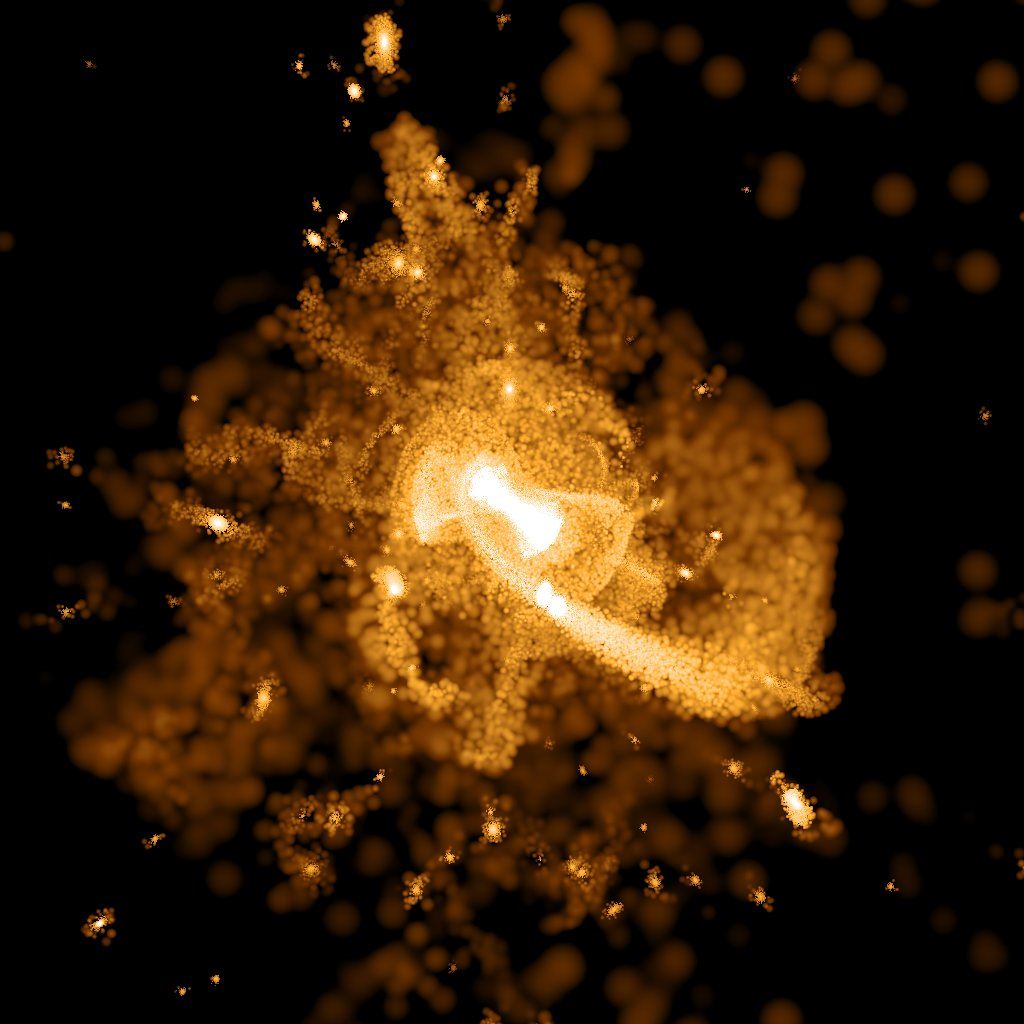[/caption]
From the Royal Astronomical Society
Many of the Milky Way’s ancient stars are remnants of other smaller galaxies torn apart by violent galactic collisions around five billion years ago, according to researchers at Durham University, who publish their results in a new paper in the journal Monthly Notices of the Royal Astronomical Society.
Scientists at Durham’s Institute for Computational Cosmology and their collaborators at the Max Planck Institute for Astrophysics, in Germany, and Groningen University, in Holland, ran huge computer simulations to recreate the beginnings of our Galaxy.
The simulations revealed that the ancient stars, found in a stellar halo of debris surrounding the Milky Way, had been ripped from smaller galaxies by the gravitational forces generated by colliding galaxies.
Cosmologists predict that the early Universe was full of small galaxies which led short and violent lives. These galaxies collided with each other leaving behind debris which eventually settled into more familiar looking galaxies like the Milky Way.
The researchers say their finding supports the theory that many of the Milky Way’s ancient stars had once belonged to other galaxies instead of being the earliest stars born inside the Galaxy when it began to form about 10 billion years ago.

Lead author Andrew Cooper, from Durham University’s Institute for Computational Cosmology, said: “Effectively we became galactic archaeologists, hunting out the likely sites where ancient stars could be scattered around the galaxy.
“Our simulations show how different relics in the Galaxy today, like these ancient stars, are related to events in the distant past.
“Like ancient rock strata that reveal the history of Earth, the stellar halo preserves a record of a dramatic primeval period in the life of the Milky Way which ended long before the Sun was born.”
The computer simulations started from shortly after the Big Bang, around 13 billion years ago, and used the universal laws of physics to simulate the evolution of dark matter and the stars.
These simulations are the most realistic to date, capable of zooming into the very fine detail of the stellar halo structure, including star “streams” – which are stars being pulled from the smaller galaxies by the gravity of the dark matter.
One in one hundred stars in the Milky Way belong to the stellar halo, which is much larger than the Galaxy’s familiar spiral disk. These stars are almost as old as the Universe.
Professor Carlos Frenk, Director of Durham University’s Institute for Computational Cosmology, said: “The simulations are a blueprint for galaxy formation.
“They show that vital clues to the early, violent history of the Milky Way lie on our galactic doorstep.
“Our data will help observers decode the trials and tribulations of our Galaxy in a similar way to how archaeologists work out how ancient Romans lived from the artefacts they left behind.”
The research is part of the Aquarius Project, which uses the largest supercomputer simulations to study the formation of galaxies like the Milky Way and was partly funded by the UK’s Science and Technology Facilities Council (STFC).
Aquarius was carried out by the Virgo Consortium, involving scientists from the Max Planck Institute for Astrophysics in Germany, the Institute for Computational Cosmology at Durham University, UK, the University of Victoria in Canada, the University of Groningen in the Netherlands, Caltech in the USA and Trieste in Italy.
Durham’s cosmologists will present their work to the public as part of the Royal Society’s 350th anniversary ‘See Further’ exhibition, held at London’s Southbank Centre until July 4th.


For more information about The Aquarius Project, click here — there are links to various papers, and lots of cool image stuff.
These are some amazingly detailed simulations of the process of galaxy formation, revealing star streams and shells formed during galaxy interactions. It’s interesting to compare these simulations to actual observations of galaxies we see in the nearby universe. A paper posted today on the arXiv contains deep imaging of 12 Seyfert galaxies that are undergoing mergers but appear as single, isolated galaxies. Examples of shells, stellar streams, ‘shelves’ and the like are quite striking.
“Seyfert galaxies that are undergoing merging but appear non-interacting” appears here: http://arxiv.org/PS_cache/arxiv/pdf/1006/1006.5547v1.pdf
@IVAN3MAN,
Great link, thanks for posting it 😀
Forgot to mention, that ‘non-interacting’ bit in the title refers to their appearance in the Sloan Digital Sky Survey.
We will have to take Sagan’s characterization to the next power – “We are made of galaxy stuff.”
Wouldn’t it be fun if the Sun, or the majority of its source material, was originally exogalactic as referenced to the Milky Way? Sure, it’s a latecomer so the likelihood isn’t all that great for the former. Still, there is a chance for any of those.
I find it interesting how spirial structure emerges from this sort of mayhem. It appears that spiral structure emerges not long (100s millions of years) after such events.
LC
How do computer simulations take things like dark energy, and other things not completely understood into account?
What if there is other “dark stuff” we don’t yet know about? How can what we don’t know about be assimilated into such computer models?
“It’s only a model….”
“Shhhh!”
—- Patsy and King Arthur
“Monty Python & the Holy Grail”
RUF, the “not completely understood” things are sufficiently understood to be used for standard cosmology, and this. (Not that dark energy would likely need to be included.)
That is the very prediction (and tested outcome to very high redshifts), that GR as a theory of gravity is ruling and that the standard cosmology is complete vs large scale.
As for other interactions, there is IIRC not much room for that if you look at the entropy content of the universe. No more long range interactions are AFAIU anticipated. (Not that DM and DE are such.)
So no worries; one could use a freezer even if one does “not completely understood” thermodynamics.
Intresting stuff